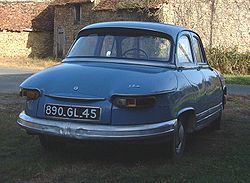
Panhard PL 17
Encyclopedia

Automobile
An automobile, autocar, motor car or car is a wheeled motor vehicle used for transporting passengers, which also carries its own engine or motor...
made by the French
France
The French Republic , The French Republic , The French Republic , (commonly known as France , is a unitary semi-presidential republic in Western Europe with several overseas territories and islands located on other continents and in the Indian, Pacific, and Atlantic oceans. Metropolitan France...
manufacturer Panhard
Panhard
Panhard is currently a French manufacturer of light tactical and military vehicles. Its current incarnation was formed by the acquisition of Panhard by Auverland in 2005. Panhard had been under Citroën ownership, then PSA , for 40 years...
from 1959 until 1965.
Presented on June 29, 1959, as successor to the Panhard Dyna Z
Panhard Dyna Z
The Panhard Dyna Z was a lightweight motor car made by Panhard of France. It was first presented to the press at a Paris restaurant named "Les Ambassadeurs" on 17 June 1953 and went into production the following year...
, the PL 17 was a development of the older car, but with an even more streamlined body than its predecessor. The four door saloon was joined in April 1963 by a five door estate version, followed two months later by a two door cabriolet.
Model name
The model's name was derived from "PL" for "Panhard et Levassor" (the original full name of the company), with the "17" coming from the sum of 5+6+6, being 5 CV (fiscal horses, in the French power rating system) plus 6 for the car's six seats, plus 6 for the car's economy — 6 L/100 km .From 1963 or 1964, the letters PL were dropped; this approximately coincided with the takeover of the passenger car part of the company by Citroën
Citroën
Citroën is a major French automobile manufacturer, part of the PSA Peugeot Citroën group.Founded in 1919 by French industrialist André-Gustave Citroën , Citroën was the first mass-production car company outside the USA and pioneered the modern concept of creating a sales and services network that...
.
Technical specifications
The car continued to use the engines of the Dyna Z, both of 851 cc. The standard one gave 42 hp (DIN), the "Tigre" gave 50 hp (DIN). Engines were twin-cylinder air-cooled "boxer" types, mounted unusually by the gearbox at the rear and by the two exhausts at the front! From July 1963 engines decreased in size to 848 cc, but performance went up to 50 hp, and 60 hp, respectively.The front wheels were driven through a four-speed gearbox with column shift, and synchromesh on the upper three gears.
The standard car weighed approximately 805 kg (1,775 lb), the Tigre 830 kg (1,830 lb). This light weight combined with the car's streamlining (with a co-efficient of drag said to be Cd 0.26) gave top speeds of 130 kilometre per hour and 145 kilometre per hour for the Tigre.
Suspension at the front by two transverse leaf springs, at the back by three torsion bars each side.
It was possible to remove the back bench to enlarge the already considerable luggage space to 527 litres (18.6 cu ft). This space was available from model year 1964, when the spare wheel was moved from beneath the luggage space to under the bonnet, where it fitted around the air filter. This was possible because the wheels have no centre — that is formed by the finned aluminium brake drums.
A break
Station wagon
A station wagon is a body style variant of a sedan/saloon with its roof extended rearward over a shared passenger/cargo volume with access at the back via a third or fifth door , instead of a trunk lid...
version was also made in small numbers.

